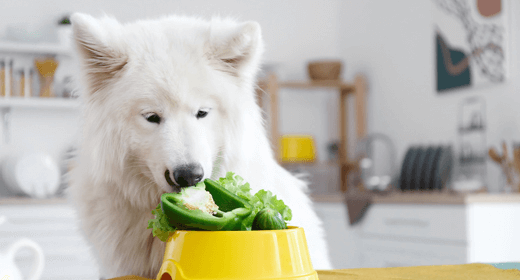

Puppies grow quickly and have special nutritional needs to keep their bodies strong. The most noticeable period of a pup’s growth phase is known as the rapid growth stage, which occurs between 2 and 6 months of age. From about 3 to 6 months, most pups will lose their puppy teeth. In fact, you might find a tooth near the feeding dish or on the floor, and this is quite normal. However, you may also be left wondering what to feed a teething puppy. This is a perfectly normal query that tends to concern a lot of pet parents.
During the teething phase, the young pup’s mouth and gums may be very sensitive, which could cause them to be a bit picky when it comes to eating. There's nothing you can do except to wait it out, even if their appetite is low for a couple of days.
While teething is painful for puppies, there are a few tips for teething puppy that can make them feel better. Here is a quick guide for you on what to give a teething puppy in terms of food and toys:
Your puppy may seem uninterested in dry food during teething. But don't switch to a new formula to stimulate your puppy's appetite. Changing food at this time can cause additional stress and intestinal upset. The tips below could help your puppy make the change:
Encourage your young dog to chew on toys by choosing chew toys that are appropriate for their size. Also, pick a variety of textures to keep them interested in the toys. You can also try giving them frozen toys that are shaped like a bone. Always keep an eye on the puppies while they are busy chewing the toys, to ensure they don’t bite off chunks. If that happens, do make sure to replace the toy immediately.
You can also give your puppy a clean and damp washcloth, chilled for a few hours. Chewing on this will also provide some much-needed relief. Do ensure that you supervise the puppy while they are chewing on this cloth so that they don’t ingest any sections of it.
Teething is a painful process for the puppies and can cause just as much inconvenience to the owners. Your puppy may lose their appetite and may experience a lot of pain and discomfort. But it is essential to get them through it all while also maintaining their diet. You can consult your vet for any major decisions or choices you make for your puppy during this time - the choice of toys, food, and other soothing methods. You will also have to keep constant vigilance to prevent your little companion from chewing on anything that may harm them, like shoes or the couch. These six months of the teething period may be hard, but you will certainly enjoy seeing them grow through this phase.
In addition to teething, ensuring excellent dental care for your dogs or puppies is of utmost importance. Discover our captivating blog post on dog dental care, and unlock a world of techniques to keep those pearly whites shining bright!
The teething process for puppies may last for about six months.
There are several ways through which you can help your puppies with the process of teething. Firstly, you can get safe chew toys for them. Secondly, you can help them get through the appetite loss. For this, you can prepare suitable teething puppy food by mixing regular dry food with parts of canned food. You can also soak their dry food in warm water for a few minutes. Apart from these steps, you can give your little furry friend a chilled clean and damp washcloth to chew on.
When your puppy is teething, you may see the following symptoms: drooling, bad breath, gum inflammation, gums bleeding, increased chewing tendency, missing teeth, and a loss of appetite.
Teething is painful for puppies and can cause them a lot of discomfort. Due to this, they may not feel like eating and can get even more reluctant to eat dry food. You can try giving them a mixture of their regular dry food with canned food or soaking their dry food for a few minutes before serving.
Two things that can soothe your puppy’s teething pain and discomfort are chew toys and a chilled clean and damp washcloth.


When visiting the store, dog owners can get overwhelmed by the array of dog food options available, from dry kibble to canned wet food and more. These processed foods may not be appealing to humans, but they contain all the nutrients that dogs need to stay healthy. Like humans, dogs also need a variety of nutrients from their food, not just from meat as their main diet, but also from grains, vegetables, and fruits. This kind of balance is usually weighed by pet food labels in kibbles or wet food in grams for different types of dogs.
For optimum health, dogs need food that is tailored and customized to their life stages, starting from when they are puppies and all the way into adulthood. Puppies have completely different nutrient needs compared to adult dogs as they are still in their early stages of life. They need enough nutrients to fuel a speedy growth, especially after transitioning away from their mother's milk. Puppies require complete and balanced nutrition with protein to help build their tissues, fats or healthy skin, hair, brain, and vision, carbohydrates for energy, vitamins, minerals, and water.
The need for balanced nutrients in puppies starts with the mother during pregnancy, followed by lactation and growth. Sufficient nourishment for the mother is pivotal in enhancing the puppies’ growth inside the womb and preparing them for life after birth. Both mother and puppy should receive well-proportioned antioxidants, DHA, and prebiotics to support their health and growth as provided by the IAMS product line, which contains DHA that is essential for puppies' brain development while also supporting the mother's pregnancy and quality of milk produced.
While puppies need the primary nutrients for growth, adult dog food has a different level of complexity. Adult dog food requires the same make-up of nutrients as puppies do but tailored to their specific needs. Recent research indicates that an adult dog requires at least 10% of its daily calories from protein and at least 5.5% from fat. Adult dogs need quality protein for firm muscles and a healthy immune system. Additionally, an adult diet can contain up to 50% carbohydrates, with fiber ranging from 2.5 to 4.5%. There is no specific prescribed amount of fibre for adult dog consumption daily, however, it is still one of the most important components in dog food to address constipation and support a healthy weight.
Adult dogs in their prime also require a balance in antioxidants to reduce systemic inflammation and restore active muscles. They should receive Vitamin E and C to support their immune system, joint health, and prevent inflammation. As they grow older, they may be exposed to different diseases from diabetes to cancers, which can be prevented by polyphenols. Parents to adult dogs must acknowledge the most suitable food for their loved one that is comprised of the right amount of nutrients and can look to the IAMS line as they are formulated to support healthy bones and joint health, scientifically proven for healthy digestion with a good fibre and prebiotic blend, as well as antioxidants for a strong immune system.
Besides life stage, balanced nutrition should be adjusted to their breed, which give insight to different factors like weight, mouth size, and energy level. This will then determine the type of kibble and food given. Smaller breeds tend to be more active, requiring the same essential nutrients and prebiotics for a healthy body as well as smaller-sized kibble designed specifically for their smaller mouths. As smaller dogs relatively have a high metabolism, higher levels of protein, fat, and essential fatty acids like omega 3 and omega 6 are some of the important nutrients that should be available in their food. On the other hand, larger breeds require foods that are lower in fat and calories, contain slightly lower levels of calcium and phosphorus, and have a specific balance of calcium-to-phosphorus ratio to support stronger bones and muscles. Owners can look to products like the small breed line from IAMS, containing 7 essential nutrients to build strong muscles, support their tiny immune system while protecting their healthy skin and coat, and the product line for adults for large breeds.
Dog parents must acknowledge and understand the unique needs, life stage and characteristics in their dog to choose the right dog food so their furry ones can grow into their healthiest selves. Make sure to visit your vet regularly to check these components as well!